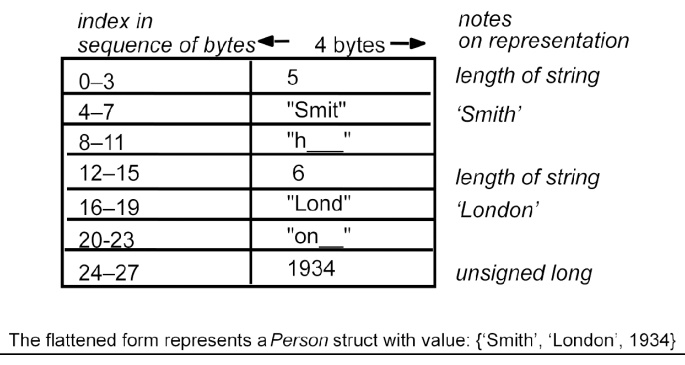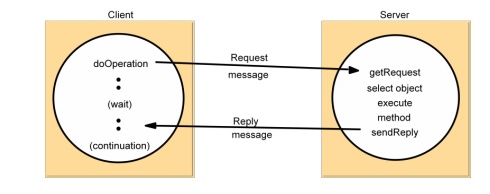Chapter: Distributed Systems : Communication in Distributed System
CORBA CDR for constructed types
CORBA CDR
for constructed types

CORBAŌĆÖs Common Data Representation (CDR)
CORBA CDR
is the external data representation defined with CORBA 2.0. CDR can represent
all of the data types that can be used as arguments and return values in remote
invocations in CORBA. These consist of 15 primitive types, which include short (16-bit), long (32-bit), unsigned short, unsigned long, float (32-bit), double (64-bit), char, boolean (TRUE, FALSE), octet
(8-bit), and any (which can
represent any basic or constructed type); together with a range of composite types, which are described
in Figure 4.7. Each argument or result in a remote invocation is
represented
by a sequence of bytes in the invocation or result message.

Marshalling in CORBA ŌĆó Marshalling
operations can be generated automatically from the specification of the types of data items to be transmitted in a
message. The types of the data structures and the types of the basic data items
are described in CORBA IDL (see Section 8.3.1), which provides a notation for
describing the types of the arguments and results of RMI methods.
Java object serialization
In Java
RMI, both objects and primitive data values may be passed as arguments and
results of method invocations. An object is an instance of a Java class. For
example, the Java class equivalent to the Person
struct defined in CORBA IDL might be:
public class Person implements Serializable {
private String name;
private String place; private int year;
public Person(String aName, String aPlace, int
aYear) {
name = aName; place = aPlace; year = aYear;
}
// followed by methods for accessing the instance
variables
}
Extensible Markup Language (XML)
XML is a
markup language that was defined by the World Wide Web Consortium (W3C) for
general use on the Web. In general, the term markup language refers to a textual encoding that represents both a
text and details as to its structure or its appearance. Both XML and HTML were
derived from SGML (Standardized Generalized Markup Language) [ISO 8879], a very
complex markup language. HTML was designed for defining the appearance of web
pages. XML was designed for writing structured documents for the Web.
XML data
items are tagged with ŌĆśmarkupŌĆÖ strings. The tags are used to describe the
logical structure of the data and to associate attribute-value pairs with
logical structures. That is, in XML, the tags relate to the structure of the
text that they enclose, in contrast to HTML, in which the tags specify how a
browser could display the text. For a specification of XML, see the pages on
XML provided by W3C [www.w3.org VI].
XML is
used to enable clients to communicate with web services and for defining the
interfaces and other properties of web services. However, XML is also used in
many other ways, including in archiving and retrieval systems ŌĆō although an XML
archive may be larger than a binary one, it has the advantage of being readable
on any computer.
Other
examples of uses of XML include for the specification of user interfaces and
the encoding of configuration files in operating systems.
XML is extensible in the sense that users can
define their own tags, in contrast to HTML, which uses a fixed set of tags.
However, if an XML document is intended to be used by more than one
application, then the names of the tags must be agreed between them. For
example, clients usually use SOAP messages to communicate with web
services.
SOAP is an XML format whose tags are published for use by web services and
their clients.
Some
external data representations (such as CORBA CDR) do not need to be self
describing, because it is assumed that the client and server exchanging a
message have prior knowledge of the order and the types of the information it
contains. However, XML was intended to be used by multiple applications for
different purposes. The provision of tags, together with the use of namespaces
to define the meaning of the tags, has made this possible. In addition, the use
of tags enables applications to select just those parts of a document it needs
to process: it will not be affected by the addition of information relevant to
other applications.

Remote object references
Java and
CORBA that support the distributed object model. It is not relevant to XML.
When a client invokes a method in a remote object, an invocation message is
sent to the server process that hosts the remote object. This message needs to
specify which particular object is to have its method invoked. A remote object reference is an identifier
for a remote object that is valid throughout a distributed system. A remote
object reference is passed in the invocation message to specify which object is
to be invoked. Chapter 5 explains that remote object references are also passed
as arguments and returned as results of remote method invocations, that each
remote object has a single remote object reference and that remote object references
can be compared to see whether they refer to the same remote object. Here, we
discuss the external representation of remote object references.
Client-server communication
public byte[] doOperation (RemoteObjectRef o, int
methodId, byte[] arguments) sends a request message to the remote object and
returns the reply.
The
arguments specify the remote object, the method to be invoked and the arguments
of that method.
public byte[] getRequest (); acquires
a client request via the server port.
public void sendReply (byte[] reply, InetAddress
clientHost, int clientPort); sends the reply message reply to the client at its
Internet address and port.

HTTP
reply message

Request-reply communication

Related Topics